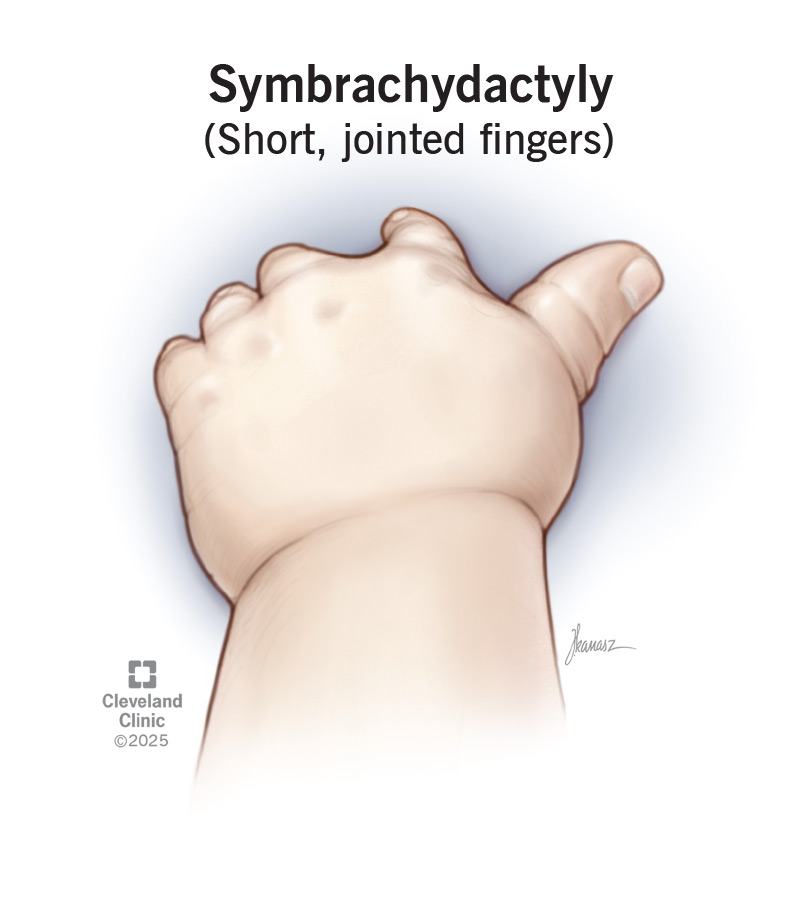Symbrachydactyly affects how your baby’s hands develop. It’s a congenital hand difference that’s present at birth. Babies with this condition have short or webbed fingers. They may be missing fingers or thumbs. The condition doesn’t affect their overall development. Treatment may include surgery, physical therapy and occupational therapy.
Advertisement
Cleveland Clinic is a non-profit academic medical center. Advertising on our site helps support our mission. We do not endorse non-Cleveland Clinic products or services. Policy

Symbrachydactyly is a rare congenital hand difference. “Congenital” means the condition is present when your baby is born. If your baby has symbrachydactyly, one of their hands is smaller than the other one. The fingers on that hand are small or short. They may be missing fingers or their thumb.
Advertisement
Cleveland Clinic is a non-profit academic medical center. Advertising on our site helps support our mission. We do not endorse non-Cleveland Clinic products or services. Policy
The condition happens during fetal development. It’s not an inherited disorder that runs in families. Symbrachydactyly (pronounced “sim-brak-ih-DAK-tuh-lee”) causes physical differences in your child’s hand. It doesn’t affect their development as they grow up.
There are four types of symbrachydactyly. The types vary based on how the condition affects your child’s hand. The types are:
Your child’s symptoms may vary depending on the type of symbrachydactyly that they have. For example, your child’s forearm may be shorter than their other forearm. But all children with this condition have fingers that are shorter than usual. They often have missing fingers and thumbs.
Advertisement
There’s no known cause of symbrachydactyly. Some experts think it may happen during development when blood stops flowing to a fetus’s arm. Arm bones start as small buds or bumps that extend from a fetus’s body. The buds or bumps need a steady flow of blood to grow and become a fully formed arm and hand. Without blood flow, a fetus’s arm, fingers or thumb may not develop normally.
A pediatrician will examine your baby’s hand. They’ll identify specific issues with your baby’s hand or fingers. They’ll use that information to diagnose the type of symbrachydactyly that your baby has. Your child’s pediatrician may do X-rays of your child’s hand. The X-ray results will help them plan treatment.
Your child’s pediatrician may classify your child’s condition as being mild, moderate or severe:
The goal of symbrachydactyly treatment is to help your child use their hand as much as possible. Your child may have surgery to fix issues that make their hands look different. Other treatment options are:
This condition won’t affect your child’s overall growth and development. But having symbrachydactyly makes them different from other children. And having a child with this condition can make you different from other parents. You and your child may feel like you’re on your own to manage how symbrachydactyly changes your lives.
If that’s your situation, ask your child’s care team about support groups for children with congenital hand differences. Those connections may help you and your child feel less isolated.
Every child is unique. If your child has symbrachydactyly, they’re unique in ways that are different from other children. They have very short fingers or are missing fingers and their thumb, and may need surgery and other treatment.
Advertisement
They may also need extra support as they grow up and learn to live with symbrachydactyly. Your child’s care team will understand the unique challenges this condition often creates. They’ll recommend treatments that are right for your child. Just as important, they’ll be there for you and your child from diagnosis and beyond.
Advertisement
Last reviewed on 08/01/2025.
Learn more about the Health Library and our editorial process.